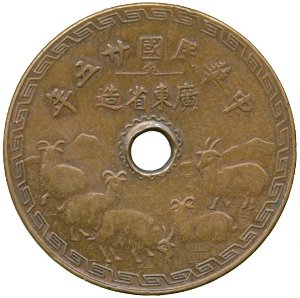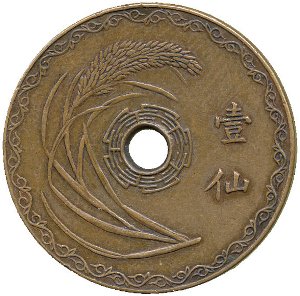A recent article in a Chinese newspaper described how a Chinese coin collector hid his coins during the Cultural Revolution (1966-1976) to save them from the Red Guards who were intent on “destroying the old”. The collector is now donating the coins to the Zhuhai Museum. Among the coins being donated is a very rare copper coin minted in 1936.

Chinese copper coin minted in 1936 displaying five goats
This coin is remarkable for its design and use of symbols.
The inscription at the top translates as “Republic of China 25th Year” and “Made in Guangdong Province”.
The lower half of the coin displays five goats. The five goats are a reference to an ancient myth concerning the city of Guangzhou (Canton) which is located in Guangdong Province.
While specific details of the myth vary, the basic story is as follows. During the reign (899 BC – 892 BC) of King Yi (周懿王) of the Zhou Dynasty, the ancient city of Guangzhou (chuting 楚庭) suffered a great famine. The fields were parched and the people were starving. One day, five immortals (“celestial beings”) descended from the sky. Each immortal rode a goat and floated down on a cloud. In the mouths of each goat was a six-eared rice stalk. The immortals blessed the land to be forever free of famine and gave the stalks of rice to the people. The immortals then rode their clouds back into the sky. The five goats remained on a hillside and were transformed into stone.
With the gift of the rice stalks the famine ended and Guangzhou has enjoyed bountiful harvests ever since.
Based on this myth, Guangzhou is known as the “City of Goats” (yangcheng 羊城), “Sheaves of Rice City” (suicheng 穗城) and the “City of Five Goats” (wuyangcheng 五羊城). In translation from the Chinese, the English words “goat” and “ram” can be used interchangeably.
On the coin, each of the five goats is shown in a different pose and in such detail as to include whiskers.
Other symbols of Guangzhou include the design surrounding the round hole which is meant to represent the battlements of the ancient wall that encircled the city.
To the left and right of the center hole are mountains from the Guangzhou area. If you look very carefully, you will notice that the mountain on the left appears to be farther in the distance than the one on the right.
The attention to detail even includes displaying patches of grass for the goats to eat to signify that food is plentiful.

The reverse side of the coin is also rich in symbolic design.
To the left of the hole is a rice stalk with six branches which refers to the rice stalks carried in the mouths of the goats in the ancient myth. This is also the official emblem of the city of Guangzhou.
Surrounding the hole is a clever design based on the Chinese character for “goat” (yang 羊). The artist has taken five of these characters and written them in ancient seal script. What appears at first glance to be a design is in fact “five goats” connected in a circle.
To the right of the hole are two Chinese characters which mean “one cent” (yi xian 壹仙). The character for “cent” (xian 仙) is used because it sounds like the English word “cent”.
However, this character (仙) also means “immortal” and thus symbolizes the five immortals that descended from the heavens to save the people from the famine.
The goat was a symbol of “good luck” to the ancient Chinese and was frequently used in sacrifice offerings to ancestors. For this reason, the Chinese word for “auspicious” or “lucky” (xiang 祥) includes the word “goat” (羊) as part of the character.
Because the “five goat” coin minted in Guangdong Province was determined not to be in accordance with the newly adopted national “legal tender” (fabi 法币) reforms of 1936, the coins were recalled and melted down after circulating for only a very short period of time. As a consequence, extremely few of these coins exist and at auction they now sell for more than $20,000.